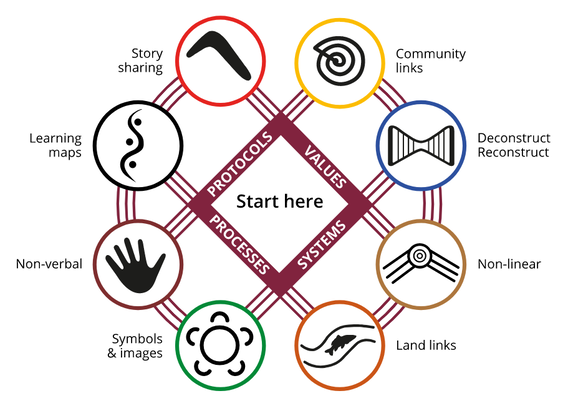
~The 8 Aboriginal Ways of Learning~
The 8 Aboriginal Ways of Learning is a teaching approach that aligns with Australian Aboriginal learning strategies and education techniques...
"Teaching through Aboriginal processes and protocols, not just Aboriginal content validates and teaches through Aboriginal culture and may enhance the learning for all students."
STORY SHARING: We connect through the stories we share. Approaching learning through narrative. Personal narratives (stories) are central.
LEARNING MAPS: We picture our pathways of knowledge. Explicitly mapping/visualising processes. Images or visuals are used to map out processes for learners to follow.
NON-VERBAL: We see, think, act, make and share without words. Applying intra-personal and kinaesthetic skills to thinking and learning. Kinaesthetic, hands-on, non-verbal learning is characteristic.
SYMBOLS & IMAGES: We keep and share knowledge with art and objects. Using images and metaphors to understand concepts and content. Symbol, image and metaphor are central to pedagogy.
LAND LINKS: We work with lessons from land and nature. Place-based learning, linking content to local land and place. Ecological and place-based, drawn from the living landscape within a framework of profound ancestral and personal relationships with place.
NON-LINEAR: We put different ideas together and create new knowledge. Producing innovations and understanding by thinking laterally. Nonlinear ways of learning are complementary, not oppositional.
DECONSTRUCT/RECONSTRUCT: We work from wholes to parts, watching and then doing. Modelling and scaffolding, working from wholes to parts. Begin with the whole structure, rather than a series of sequenced steps. Holistic, global, scaffolded and independent learning orientations of students.
COMMUNITY LINKS: We bring new knowledge home to help our local social systems. Centring local viewpoints, applying learning for comm
https://www.painaustralia.org.au/static/uploads/files/8-aboriginal-ways-of-learning-factsheet2-wfklwmnralub.pdf
 Except where otherwise noted, content on this site is licensed under a Creative Commons Attribution-NonCommercial-ShareAlike 3.0 Australia License.
Except where otherwise noted, content on this site is licensed under a Creative Commons Attribution-NonCommercial-ShareAlike 3.0 Australia License.
QUT acknowledges the Traditional Owners of the lands where QUT now stands.


